SHI‘I ISLAM TIMELINE
632: The event of Al-Ghadir occurred when the Prophet Muhammad is believed to have designated his cousin and son-in-law ‘Ali as his successor.
656–661: Caliphate of ‘Ali, the first Shi‘i Imam assumed his position.
656-657: ‘Ali was challenged by opponents at the Battle of the Camel and the Battle of Siffin.
661: Imam Hasan, ‘Ali’s first son, relinquished the caliphate to Umayyad Caliph Mu‘awiyya.
680: Imam Husayn, ‘Ali’s second son, fought and was martyred at the Battle of Karbala’.
740: Zayd ibn ‘Ali launched a failed revolt in Kufa against the Umayyad caliphate, leading to the emergence of Zaydi Shi‘ism.
730s–765. The elaboration of Twelver doctrines and jurisprudence by Imam Ja‘far al-Sadiq took place.
765: The was a succession crisis upon Ja‘far al-Sadiq’s death and an emergence of Isma‘ili Shi‘ism.
873-874: The occultation of Muhammad al-Mahdi, considered the 12th Imam by Twelver Shi‘a, began.
897: A Zaydi Imamate was established in Yemen.
945–1055: Control of the ‘Abbasid caliphate by the Shi‘i Buyid dynasty took place, and there was a flourishment of Twelver Shi‘ism.
909–1171: Isma‘ili Imams ruled over the Fatimid caliphate.
1090: Hasan al-Sabbah captured the fortress of Alamut in Iran.
1094: A split occurred between Nizari and Musta‘li Isma‘ilis.
1132: The Imam recognized by the Musta‘li Tayyibi Isma‘ilis went into concealment.
1501: Iran’s Safavid Empire adopted Shi‘ism as religion of state.
1800s: The emergence and development of the marja‘iyya in Twelver Shi‘ism took place.
1818: The Nizari Isma‘ili Imam adopted the title of Aga Khan.
1890: A tobacco protest took place in Iran.
1905–1911: The Iranian Constitutional revolution took place.
c1958: The Iraqi Da‘wa Party was founded.
1962: The Zaydi Imamate in north Yemen came to an end.
1970: Ayatollah Khomeini elaborated his doctrine of velayat-e faqih.
1979: Following the success of the Iranian revolution, the Islamic Republic of Iran was established.
1982: The Lebanese Hizbullah was founded.
1986: Nizari Isma‘ili communities adopted a “World Constitution.”
1989: Ayatollah Khamenei succeeded Ayatollah Khomeini as Supreme Leader of the Islamic Republic of Iran.
2005: Iraqi Shi‘a obtained a majority in the first parliamentary elections after the fall of the Ba‘th regime.
2011: Arab spring protests took place in Bahrain.
2014: The Houthi movement took control of Yemen’s capital.
FOUNDER/GROUP HISTORY
For Shi‘a Muslims as for all Muslims alike, the Prophet Muhammad was, as the “seal of the prophets,” the founder of Islam and the first leader of the nascent Muslim community. Although it took generations for Sunni and Shi‘i Islam to crystallize into distinctive denominations, the beginnings of a proto-Shi‘ism can be traced back to the succession crisis following the Prophet’s death in 632. A minority group of Muslims held that Muhammad had designated his cousin and son-in-law ‘Ali to be his successor. This group became known as the partisans of ‘Ali – shi‘at ‘Ali, the term from which Shi‘ism is derived. Bestowed with the title of Imam, ‘Ali can thus be called the founding figure of Shi‘ism. The belief in his legitimate leadership constitutes the major common denominator of this otherwise internally diverse branch of Islam, a diversity this profile seeks to capture.
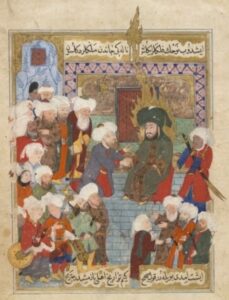
Another view, which came to represent the Sunni position, however prevailed. It held that Prophet Muhammad had not appointed a successor and that one of his close companions should be given allegiance as leader (or caliph) of the community. ‘Ali’s turn eventually came when he was selected as the fourth caliph (656–661) [Image at right]. He faced many challenges, however. He was soon confronted at the Battle of the Camel by a group who accused him of complacency in the murder of his predecessor, Caliph ‘Uthman. Ali’s rule was further challenged by Mu‘awiyya, the then powerful governor of Syria and a cousin of the late Caliph ‘Uthman. Their armies met at the Battle of Siffin in 657, and although an arbitration agreement was reached, ‘Ali’s leadership was weakened. Former supporters turned against him. It was at the hand of a member of a dissident group, Kharijites, that ‘Ali was assassinated in 661 in the Iraqi city of Kufa. He was buried in nearby Najaf, which later became an important Shi‘i shrine city.
After ‘Ali’s death, the Shi‘a turned to his eldest son Hasan as their Imam. Hasan did not exercise temporal power as he relinquished the leadership of the Muslim community to Mu‘awiyya, the founder of the Umayyad caliphate. In contrast, ‘Ali’s second son Husayn, who succeeded his brother as third Imam in 670, attempted to resist the establishment of Umayyad dynastic rule. In 680, he and seventy-two of his companions fought and lost the Battle of Karbala’ (in today’s Iraq) against the army of Caliph Yazid, Mu‘awiyya’s son and successor. This event, which resulted in the martyrdom of Husayn, is a major landmark of Shi‘i history and is commemorated annually by most Shi‘a Muslims.
Shi‘ism underwent innumerable splits in the first centuries of Islam. Splits were initially the result of disputes following the death of an Imam over the identity of his successor, though specific doctrinal positions then developed. Many movements that emerged in this formative period were short-lived. Three main branches of Shi‘ism have continued until the present day.
Twelver Shi‘ism is by far the majority branch today, though this was not the case in earlier history (Newman 2013:52). It recognizes a line of twelve Imams, starting with ‘Ali, followed by his sons Hasan and Husayn, and then the descendants of Husayn. Although the Imams were considered by the Shi‘a to be the legitimate holders of both religious and political authority, they were unable to exercise actual political power (Ali’s caliphate being the exception). Instead, they concentrated on their role as interpreters of the law and as teachers. The sixth Imam, Ja‘far al-Sadiq (d. 765), contributed much to the elaboration of doctrine and jurisprudence. For this reason Twelver Shi‘ism is also known by his name as the Ja‘fari school. The attitude of political cautiousness adopted by the Imams was no safeguard against persecution by the rulers of their time, however. They all died poisoned, Shi‘i historiography maintains (Momen 2016:ch. 2). The destiny of the twelfth Imam was different. Following the death of his father, the eleventh Imam in 873/874, the belief emerged that he had been concealed by God, thereby protecting him from the persecution endured by previous Imams. Still considered the legitimate authority, this hidden Imam initially communicated with the community through four successive agents – a period known as the minor occultation. 941 marked the start of the major occultation when direct contact with the Imam ended, a situation that has continued until the present day. In the tenth and elevnth centuries, a Shi‘i dynasty. called the Buyid, ruled over the heartlands of the Abbasid caliphate, providing favorable conditions for the further canonization of Twelver Shi‘i doctrines and practices. The now 1,000-year-old seminary of Najaf (Iraq) located around the burial site of Imam ‘Ali continues as a major center of scholarship and is today headed by Grand Ayatollah ‘Ali al-Sistani (b. 1930).
Zaydism and Isma‘ilism are the main minority branches of Shi‘ism. Sometimes called Fiver and Sevener Shi‘ism, they diverged from the Twelver line of Imams from the fifth and the sevent Imam, respectively. The context for the emergence of the Zaydi branch was the disarray in which the Shi‘i community found itself after the defeat of Imam Husayn at the Battle of Karbala’. Unlike the Imams recognized by Twelver Shi‘a, who adopted a politically quietist stance, other claimants to the position advocated an activist role. This was the case of Zayd ibn ‘Ali, a grandson of Husayn and the eponym of the Zaydis, who rebelled against Umayyad rule in 740. His followers recognized in his quest to capture power the qualities of an Imam, even though he was killed in battle. Accordingly, a Zaydi Imam could be any descendant of Imam Hasan or Husayn who would rise against rulers perceived to be illegitimate. It can however well happen that there is no such Imam, as is currently the case.
Isma‘ili Shi‘ism developed separately from Twelver Shi‘ism in the context of a succession crisis after the death of the sixth Imam. His eldest son Isma‘il had predeceased his father. While the Twelver Shi‘a turned to the second son who was alive, the Isma‘ilis argued that the Imamate had gone through the deceased Isma‘il to his own son Muhammad. In the following centuries, intra-Isma‘ili disputes over the identity of the Imam resulted in further splits. The Imam was initially believed to be in concealment (satr) until one of his descendants reappeared as Imam in the early tenth century and founded the Fatimid dynasty who ruled a large Muslim empire to which we will return. One group, now extinguished, rejected this claim. Another split took place upon the death of a Fatimid Imam and Caliph in 1130. The smaller group, the Musta‘li Tayyibi Isma‘ilis, considered that the Imamate continued in concealment but was represented on earth by a living vicegerent called a da‘i. Two sub-groups eventually came to recognize different lines of vicegerents from the late sixteenth century: the Da‘udi Bohras and the Sulaymanis whose respective da‘i currently lives in Mumbai and Yemen. The other and the largest group, the Nizari Isma‘ilis, have followed another line of Imams who were at times concealed but most often physically present and started to assume the title of Aga Khan in 1818. In office since 1957, Karim Aga Khan IV is currently the forty-nineth Nizari Isma‘ili Imam. Among the various branches of Shi‘ism, Nizari Isma‘ilis are the only community with an Imam who is physically present.
Other smaller Shi‘a minority groups developed separately from the Twelver Shi‘i tradition in the course of history and have survived until today (Alawi, Alevi, Bektashi and Ahl-e Haqq Shi‘ism) (Momen, 2016:208–15). The origins of the Druze religion can be found in Isma‘ili Shi‘ism, before this religious tradition took a life of its own outside the fold of Islam proper.
In general terms, the history of Shi‘i Islam has been less associated with the exercise of temporal power than Sunni Islam. The Umayyad, Abbasid, Ottoman, and Mughal empires were Sunni-ruled. Yet, several Shi‘i states and empires (first Zaydi and Isma‘ili, and later Twelver) came to existence and marked Muslim history.
Born and initially active in Iraq, the Zaydi movement moved away from the heartlands of the caliphate in the mid-nineth century and successfully established independent states in Iran’s  Caspian region and in Northern Yemen (897). The Zaydi Imamate in Yemen was long-lasting. A succession of Imams continued to exert power intermittently into the modern period, until the last one was deposed in 1962 and the Kingdom of North Yemen turned into a republic. [Image at right] The Houthi movement emerged in the 1990s as part of a Zaydi religio-cultural revival and the political failures of the Yemeni government. Since 2014, in the context of Yemen’s descent into civil war, the Houthis have controlled the capital of Sanaa and large parts of the country, however without claiming the Imamate.
Caspian region and in Northern Yemen (897). The Zaydi Imamate in Yemen was long-lasting. A succession of Imams continued to exert power intermittently into the modern period, until the last one was deposed in 1962 and the Kingdom of North Yemen turned into a republic. [Image at right] The Houthi movement emerged in the 1990s as part of a Zaydi religio-cultural revival and the political failures of the Yemeni government. Since 2014, in the context of Yemen’s descent into civil war, the Houthis have controlled the capital of Sanaa and large parts of the country, however without claiming the Imamate.
The Isma‘ili movement gave birth to one of the greatest Muslim empires of the medieval period. The Fatimid empire ruled from 909 to 1171, stretching from North Africa to the Levant and western Arabia, and with Cairo as capital. Headed by a dynasty of Imams who adopted the title of caliph, it served as a counter-caliphate to the Sunni-ruled Abbasid empire. The assumption of state power prompted the formalization of Isma‘ili jurisprudence, for which the scholar Qadi Nu‘man (d. 974) is credited. The mosque of Al-Azhar was founded and developed as an institution of higher education in this period; it later became and remains the heart of Sunni scholarship. The religious policy of the Fatimid caliphate did not entail conversion of their Sunni-majority subjects. This explains why the former Fatimid regions of Egypt and North Africa host only tiny Shi‘i populations.
The Fatimids engaged in more assertive missionary work outside the borders of their empire, especially to the east in Yemen, Iraq, Iran, and India. Famously, the missionary chief in Persia, Hasan al-Sabbah, adopted a revolutionary course of action. The state he and his successors  maintained in parts of Iran and Syria, with the fortress of Alamut as stronghold (1090–1256), became fertile ground for European mythologization of the Nizari Isma‘ilis as the infamous Assassins; from Marco Polo’s Book of the Marvels of the World [mage at right] to the best-seller novel Alamut by Slovenian Vladimir Bartol (1937) and the video game AssaIssins Creed. Isma‘ili Shi‘ism lost political prominence afterwards. The Nizari Imams assumed more of a spiritual and community leadership function, which they exercised from Mumbai after Aga Khan I moved the headquarters of the Imamate in the mid-nineteenth century. Aga Khan III engaged in Muslim politics as one of the founders of the All-India Muslim League, which is introduced in the Sunni Islam WRSP entry, while he also gained prominence on the international scene as president of the League of Nations in 1937–1938 (Daftary 1998:200–01).
maintained in parts of Iran and Syria, with the fortress of Alamut as stronghold (1090–1256), became fertile ground for European mythologization of the Nizari Isma‘ilis as the infamous Assassins; from Marco Polo’s Book of the Marvels of the World [mage at right] to the best-seller novel Alamut by Slovenian Vladimir Bartol (1937) and the video game AssaIssins Creed. Isma‘ili Shi‘ism lost political prominence afterwards. The Nizari Imams assumed more of a spiritual and community leadership function, which they exercised from Mumbai after Aga Khan I moved the headquarters of the Imamate in the mid-nineteenth century. Aga Khan III engaged in Muslim politics as one of the founders of the All-India Muslim League, which is introduced in the Sunni Islam WRSP entry, while he also gained prominence on the international scene as president of the League of Nations in 1937–1938 (Daftary 1998:200–01).
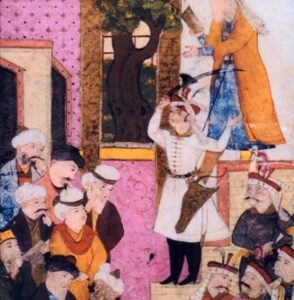
A number of earlier local dynasties notwithstanding, it was in the early modern period, in Iran, that Twelver Shi‘ism became most strongly associated with state power. In 1501, the newly established Safavid empire adopted Shi‘ism as religion of state [Image at right]. An assertive yet slow conversion of the majority-Sunni population ensued (Abisaab 2004), while great intellectual and cultural achievements marked the period (Newman 2009). If the Safavid kings claimed religious legitimacy as descendants from the Prophet, the Qajar dynasty who ruled over Iran from 1796 until 1925 did not enjoy such legitimacy. Qajar rule started to face a more politically engaged clergy, who led a successful popular protest against a tobacco concession granted to the British in 1890 and participated in (both for and against) the Constitutional Revolution of 1905–1911. Monarchical rule in Iran was put to an end by the Iranian revolution and the establishment of an Islamic Republic in 1979.
Recent decades witnessed the rise of Shi‘i Islamist groups in various countries. These movements have had their own trajectory, agenda, and modes of action, ranging from armed action to electoral participation. The Iraqi Da‘wa Party (Call to Islam Party) started in the late 1950s as a reform movement aimed to respond to the challenges of secular and communist ideologies, then engaged in opposition to Saddam Hussain, and eventually held Iraq’s prime ministership following regime change in 2003. In Lebanon, Hizbullah was created in 1982 out of the context of the Lebanese civil war (1975–1990) and the Israeli invasion of 1982, and has developed as to become a major political, military, charitable, and cultural actor in the country (Norton 2014).
Today, Shi‘a Muslims of all sub-denominations represent an estimated ten to thirteen percent of the total Muslim population worldwide. Their geographical distribution is part and parcel of some of the historical developments outlined above. In addition to Iran and Azerbaijan, which also underwent conversion to Twelver Shi‘ism during the Safavid period, Shi‘a constitute numerical majorities in Sunni-ruled Bahrain where they live as a political minority, as was also the case of the Shi‘a of Iraq until regime change in 2003. Syria’s al-Asad regime represents the opposite case of a Shi‘a minority (the Alawi sub-group) holding power. Lebanese Shi‘a are probably the country’s largest religious group and the confessional political system grants them the position of Speaker of Parliament. Sizeable Shi‘a minorities in the Middle East are also found in Yemen, Saudi Arabia, Kuwait, and Turkey, while Shi‘a are almost inexistent in North Africa and Egypt. In South Asia, Pakistan is home to the second largest Shi‘a community after Iran, followed by India, while the ethnic Hazara minority of Afghanistan is also Shi‘a. Communities of various sizes can also be found in Southeast Asia, East Africa, and Latin America. (Pew 2009:8–11; 38–41)
While Shi‘a Muslims in Europe and North America are often qualified as a minority within a minority, they have assumed a growing public visibility as exemplified by the purpose-built mosque established in 2005 by the Shi‘a-run Islamic Centre of America in Dearborn, Michigan and considered the largest mosque in the United States (the Lebanese Shi‘a community of Dearborn is the subject of the excellent ethnographic work by Walbridge 1996).
DOCTRINES/BELIEFS
Shi‘a Muslims hold the common Muslim beliefs such as in the oneness of Allah, prophecy and the divinely revealed scriptures, as well as life after death. While justice (‘adl) is recognized as one of God’s many attributes by all Muslims, the view that divine justice is rationally intelligible to humans is particularly central to Shi‘i theology, with the affirmation of (some degree of) free will as a consequence (Haider 2014:ch.1).
The most distinctive foundational belief of Shi‘ism is the Imamate, defined as the legitimate leadership of the Imams. From a doctrinal point of view, the historical dispute over the succession of Prophet Muhammad was not merely about who should lead the community. Abu Bakr who became the first caliph or ‘Ali whom the Shi‘a considered the legitimate successor. Rather the dispute captured diverging views on the nature of post-prophetic leadership itself. The Sunni conception was essentially that of a temporal leadership, whose selection was left to the Muslim community. The most distinctive foundational belief of Shi‘ism is the Imamate, defined as the legitimate leadership of the Imams.
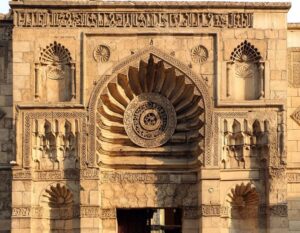
The Shi‘i Imamate is often schematized as merely hereditary leadership. While the Imams come from the Prophet Muhammad’s progeny (ahl al-bayt) through his daughter Fatima and his son-in-law ‘Ali, they owe their stature to God’s will. The belief in this divinely-ordained leadership is based on several signs found in the Qur’an, such as the verse inscribed in the medallion on the façade of the Fatimid Mosque of al-Aqmar in Cairo [Image at right], and on more or less explicit statements made to that effect, according to the Shi‘i interpretation, by Muhammad as per God’s command (Haider 2014:53–66). The most emblematic instance was the episode of Al-Ghadir when, not long before his death, the Prophet declared: “To whomever I am his mawla, ‘Ali is his mawla.” While his words are almost unanimously accepted in the Muslim tradition, the interpretation of the Arabic term mawla has been debated. In the Sunni understanding, the word means here someone who is loved. For the Shi‘a, it means “master,” hence indicating a recognition of ‘Ali’s authority over the community. The principle of divinely-inspired designation (nass) also applies to the other Imams of both the Twelver and Isma‘ili lines who passed down leadership to one another. Divine designation is less important to Zaydi doctrine and applies only to ‘Ali and his two sons. Subsequently a Zaydi Imam could emerge on the basis of his descent from ‘Ali and Fatima, his religious knowledge, as well as by leading an uprising and calling believers to recognize his leadership. In practice however, the Zaydi Imamate in Yemen became dynastic in its later stages (Madelung 2002).
The authority of the Shi‘i Imams is broad and comprehensive. They are not Prophets, but the guardians and interpreters of the divine message revealed to Prophet Muhammad. According to both Twelver and the Isma‘ili doctrines, the Imams cannot go wrong because they are immune from sin and error. Endowed by God with special knowledge, they are able to understand the exoteric and esoteric dimensions of religion, the latter aspect being particularly central to Isma‘ili theology and practice. Like the Prophet Muhammad, the Imams also have the power of intercession. Zaydi doctrine rejects the infallibility of the Imams; an Imam’s authority is based on his qualifications as a jurist and his political qualities given the expectation that he heads a Muslim state (Haider 2010:438–40). In a sense, the Zaydi conception of the Imamate is more “this worldly” (Messick 1993:37) than that of its other Shi‘a counterparts.
Some of the Shi‘i conceptions of the Imamate also accommodate the idea of a physically absent Imam. The last Twelver Shi‘i Imam has been in occultation since the late nineth century and is expected to return at the end of times as the Mahdi (“the rightly-guided one”; an eschatological messianic figure), along with Jesus, in order to establish a rule of justice. While the twelfth Imam remains the legitimate authority during the occultation, for practical purposes the doctrine of the deputyship of the Imam has allowed Twelver religious scholars to perform his religious functions. Although the Nizari Isma‘ili Imams of the past centuries have been physically present, there were earlier periods when they were concealed, as is also the case of the Musta‘li Tayyibi Isma‘ili Imams who have been hidden since 1132 but represented by the da‘is. In contrast, the idea of occultation is absent in Zaydi Shi‘ism; there might not be an Imam at all times but whenever one emerges, he must be living and present.
With regard to legal doctrines, several schools of jurisprudence have emerged out of Shi‘ism and its branches. A specificity is that, in addition to the Qur’an and the sunna (practice) of Prophet Muhammad which are foundational sources of law for all Muslims, Shi‘a jurisprudence also draws on the teachings and legal interpretations of the Imams. Within the Zaydi tradition, the Hadawiyya law laid out by the Imam who founded the first Zaydi state in Yemen remained dominant into the modern period, although it underwent a Sunnification process from the sixteenth century at the impetus of revisionists scholars (Haykel and Brown n.d.). Zaydism is often described as the closest of all Shi‘i branches to Sunni Islam. In Twelver Shi‘ism, the Imams initially provided legal rulings, some of which are specific to this branch of Islam, such as a greater equality granted to women in matters of inheritance or the permissibility for a couple to contract a temporary marriage (mut‘a) for a defined period of time. Following the occultation of the twelfth Imam, the religious scholars eventually assumed an important legal role. Two competing methodologies of jurisprudence emerged. The now mainstream Usuli (rationalist) school emphasizes the role of the intellect (‘aql) for interpreting the Qur’an and the traditions, an approach rejected by the minority Akhbari (traditionalist) school (Gleave 2007). The Usuli approach contributed to the development of the authority of the religious scholars qualified to exercise this rational interpretation – the mujtahids, also establishing a hierarchy between them and those who should follow their legal opinions. Isma‘ili law was canonized in the Fatimid period, but continued to evolve afterwards given the prerogative of the Nizari Imams to adjust legal provisions and the practice of rituals to the exigencies of the time. For instance, Aga Khan III enacted reforms against veiling and gender segregation and in support of greater equity for women in matters of marriage and divorce (Haider 2010:194).
Although Shi‘ism is often described as a religion of protest, Shi‘i political theory accommodates different political attitudes. If classical Zaydi doctrine emphasized a more activist approach with the requirement that the Imam leads an uprising against the unjust ruler, this interpretation gave way, as part of the Sunnification process mentioned above, to a greater unconditional acceptance of rulers similar to classical Sunni political theory. Twelver and Isma‘ili doctrines came to terms with the Imams not exercising power, in spite of their theoretical entitlement to both religious and temporal authority. The permissibility for believers to dissimulate their faith in case of danger, a doctrine known as taqiyya, also supports an attitude of political caution in the face of injustice. While Twelver religious scholars have gradually assumed the religious functions of the twelfth Imam in his absence, they stopped short of claiming his political authority. This was the step taken by Ayatollah Khomeini with his doctrine of velayat-e faqih (guardianship of the jurist), which argued for the establishment of an Islamic state under the governance of one or several jurists (Khomeini 2002). At first a theoretical exercise when Khomeini elaborated it in 1970 during his exile in Iraq, his doctrine was eventually 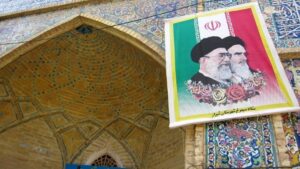 institutionalized in the Islamic Republic of Iran. The Iranian political system is however hybrid in that it combines clerical rule by a Supreme Leader, held first by Ayatollah Ruhollah Khomeini (d. 1989) and then by Ayatollah ‘Ali Khamenei [Image at right], with other elected political and legislative offices. Khomeini’s doctrine of velayat-e faqih has remained highly contested amongst Shi‘i scholars. Twelver political thought and practices have also supported various democratic models of governance (Rahimi 2012).
institutionalized in the Islamic Republic of Iran. The Iranian political system is however hybrid in that it combines clerical rule by a Supreme Leader, held first by Ayatollah Ruhollah Khomeini (d. 1989) and then by Ayatollah ‘Ali Khamenei [Image at right], with other elected political and legislative offices. Khomeini’s doctrine of velayat-e faqih has remained highly contested amongst Shi‘i scholars. Twelver political thought and practices have also supported various democratic models of governance (Rahimi 2012).
RITUALS/PRACTICES
Daily prayers, purification through charity (zakat), fasting during the month of Ramadan, and the hajj (pilgrimage to Mecca) are core Muslim and thus also Shi‘i practices. There are some specificities in the ways various Shi‘i sub-denominations perform them, as is also the case 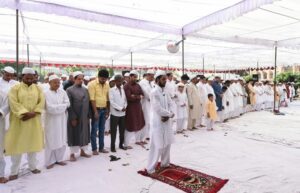 between different Sunni schools of law. To take the example of prayer, Twelver and Zaydi Shi‘a combine some of the five daily prayers and perform prayer three times a day, while the position of hands also differs from some Sunni schools, as can be seen in the [Image at right]. A Twelver Shi‘i specificity, also shown in the picture, is the practice to prostrate upon a small clay tablet called a turba which is ideally made from the sacred soil of Karbala’ where Imam Husayn was killed. In line with its theology focused on the inner and hidden meaning of religion, Isma‘ili Shi‘ism accords greater importance to the esoteric dimension of rituals than to the outward and shari‘ (legal) aspects emphasized by other Shi‘a and Sunni schools of law. Held in a place called a jamatkhana (lit. assembly-house), Isma‘ili rituals have been dynamic in type and form given the prerogative of the living Imam to formulate them for the conditions of the time.
between different Sunni schools of law. To take the example of prayer, Twelver and Zaydi Shi‘a combine some of the five daily prayers and perform prayer three times a day, while the position of hands also differs from some Sunni schools, as can be seen in the [Image at right]. A Twelver Shi‘i specificity, also shown in the picture, is the practice to prostrate upon a small clay tablet called a turba which is ideally made from the sacred soil of Karbala’ where Imam Husayn was killed. In line with its theology focused on the inner and hidden meaning of religion, Isma‘ili Shi‘ism accords greater importance to the esoteric dimension of rituals than to the outward and shari‘ (legal) aspects emphasized by other Shi‘a and Sunni schools of law. Held in a place called a jamatkhana (lit. assembly-house), Isma‘ili rituals have been dynamic in type and form given the prerogative of the living Imam to formulate them for the conditions of the time.
In addition, several distinctively Shi‘i practices stem out of the belief in the Imamate. One is the annual celebration of the event of Ghadir 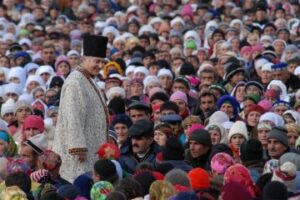 khumm when Prophet Muhammad is believed to have designated Imam ‘Ali as his successor. Having a living Imam, Nizari Isma‘ili Shi‘a also celebrate the anniversary of the accession of the current post-holder, as well as his birthday. The opportunity to participate in a didar (seeing) of the Aga Khan is a particularly important and joyful in the life of an Isma‘ili [Image at right]. The Imams recognized by Twelver Shi‘a are figures of the past who remain central, along with other historical figures of the Prophet’s family, to acts of individual and communal piety, such as visitation to their shrines in Iraq, Iran, and Syria, and special services held on their birth or death anniversaries. Zaydi Shi‘ism accords less importance to commemorative and visitation practices, while it rejects the idea of intercession.
khumm when Prophet Muhammad is believed to have designated Imam ‘Ali as his successor. Having a living Imam, Nizari Isma‘ili Shi‘a also celebrate the anniversary of the accession of the current post-holder, as well as his birthday. The opportunity to participate in a didar (seeing) of the Aga Khan is a particularly important and joyful in the life of an Isma‘ili [Image at right]. The Imams recognized by Twelver Shi‘a are figures of the past who remain central, along with other historical figures of the Prophet’s family, to acts of individual and communal piety, such as visitation to their shrines in Iraq, Iran, and Syria, and special services held on their birth or death anniversaries. Zaydi Shi‘ism accords less importance to commemorative and visitation practices, while it rejects the idea of intercession.
The anniversary of the martyrdom of Imam Husayn is a key date in the religious calendar, especially for Twelver Shi‘a. The ‘Ashura rituals associated with this commemoration include memorial services, passion plays re-enacting the Battle of Karbala’ (ta‘ziyah), and street processions. Mourning is expressed through tears, chest beating, and self-flagellation with whips or self-cutting with blades. Practices vary across different cultural contexts, and the permissibly of shedding blood has been debated among Twelver religious scholars. Blood donation drives are gaining currency as an alternative to the more controversial bloodletting rituals. Forty days after the Ashura, the arba‘in is the occasion of a pilgrimage to the 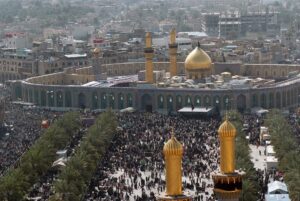 shrine of Imam Husayn in Karbala’ [Image at right]. Banned under the regime of Saddam Hussain, the millions of worshippers it attracts now every year makes it one of the world’s largest pilgrimages.
shrine of Imam Husayn in Karbala’ [Image at right]. Banned under the regime of Saddam Hussain, the millions of worshippers it attracts now every year makes it one of the world’s largest pilgrimages.
Husayn’s struggle and martyrdom has offered a paradigm for the politicization of Shi‘ism, especially in recent decades. As popularized in a slogan attributed to ‘Ali Shari‘ati (d. 1977), an influential lay intellectual active before the Iranian revolution, “Every day is Ashura, every land is Karbala’,” Husayn serves as a source of inspiration for other purposes than revolutionary activism, however, as exemplified by Who is Hussain, a global grassroots charitable and social justice movement built on the values of compassion, justice, and dignity he embodied (see website in the reference list). Husayn’s sister Zaynab, who demonstrated leadership and courage in the face of adversity in the aftermath of the battle of Karbala’, remains a potent role model for Shi‘a women (Deeb 2006).
ORGANIZATION/LEADERSHIP
As we have seen, the Imams are the central figures of authority in Shi‘ism. In the branches in which the Imam is present, the Imam of the time exercises leadership himself. This is the case of the Aga Khan of the Nizari Isma‘ilis to whom community members, the murids, testify their obedience and devotion through an oath of allegiance (bay‘a). In turn, the Aga Khan assumes the charge of all religious and community matters. The Imamate thus ensures a high level of centralized organization, a process which was further reinforced by the adoption in 1986 of the “World Constitution” that provides a common framework for the governance of Isma‘ili communities (called jamati) and their external relations while allowing flexibility for regional and local differences (Daftary 1998:208). The Imam is also the recipient and administrator of religious tithes (called dasond) paid by his followers and which he reallocates for the benefit of the community. A flagship institution founded and headed by the current Aga Khan, Karim Aga Khan IV, is the Aga Khan Development Network, which supports a variety of programs in education, health, economic development, humanitarian relief, and culture (Aga Khan Development Network website 2020).
In Twelver Shi‘ism, the twelfth Imam remains the legitimate holder of authority, in spite of being in occultation. In the context of his absence, the ‘ulama’ (religious scholars), and particularly those qualified as mujtahid, have however come to assume many of the Imam’s prerogatives to guide and cater for the needs of Twelver Shi‘a. The early nineteenth century witnessed the development of a system of clerical authority called the marja‘iyya by which the laity should follow the guidance of one such qualified scholar as their source of emulation (marja‘ al-taqlid). Unlike the Catholic papacy, to which the marja‘iyya is often compared, there is no formal selection procedure. Knowledge and piety are important criteria to be recognized as a marja‘, but other more mundane considerations might come into play. In effect, several marja‘s assume the position at any given time. Most of them are based in the seminaries of Iraq or Iran, and their authority often extends transnationally. Ayatollah ‘Ali Sistani of Najaf is currently the most widely followed marja‘ worldwide, while other grand ayatollahs, including Iranian Supreme Leader ‘Ali Khamenei, also have larger or smaller shares of emulators.
A marja‘ provides legal opinions on religious practice, which his followers can consult in his treatise of practice or by asking questions to him or through his agents who represent him in various localities. As recipient of the religious tithes (khums; one fifth of one’s annual surplus of income or profit) paid by his followers, a marja‘ also caters for the religious, educational, social,  and humanitarian needs of Shi‘a communities. The Al-Khoei Foundation established by the late Ayatollah Khoei in 1989 is a notable example of an international NGO with branches in several Muslim-majority countries and in the West (Corboz 2015), such as its religious center in New York which anyone on the route from JKF airport to the city will notice [Image at right].
and humanitarian needs of Shi‘a communities. The Al-Khoei Foundation established by the late Ayatollah Khoei in 1989 is a notable example of an international NGO with branches in several Muslim-majority countries and in the West (Corboz 2015), such as its religious center in New York which anyone on the route from JKF airport to the city will notice [Image at right].
Twelver religious scholars have also assumed different political leadership positions in the contemporary period. In contrast to their Sunni counterparts, Shi‘a Islamist organizations have often been under clerical leadership, however in combination with modern party structures. In the Islamic Republic of Iran, the office of Supreme Leader is reserved to a religious scholar, although the requirement that he is a marja‘ was dropped in the 1989 revision of the constitution when Ayatollah Khamenei succeeded Ayatollah Khomeini. The institutions of the Islamic Republic also include an elected parliament and presidency for which both lay and clerical politicians compete. In post-2003 Iraq, the position of prime minister has been filled by lay Shi‘a politicians, not by clerical figures of Shi‘a parties.
ISSUES/CHALLENGES
The belief in the Imamate which, as we have seen throughout this profile, is at the core of Shi‘ism, raises issues related to the authority exercised by the Imams themselves, or by their representatives. In terms of internal organization, one issue concerns the hierarchical relationships between the Isma‘ili Aga Khan and his murids or Twelver marja‘s and their emulators. To what extent is top-down authority questioned and contested from below, especially under the forces of modernization and globalization? As brilliantly captured in recent ethnographic research among Twelver Shi‘a communities (Clarke 2018:ch. 13; Fibiger 2015; Zargar 2021), the laity exercises more autonomy and flexibility in their practice of emulation than is often assumed. West-based Shi‘a Muslims, especially the younger generations, also expect a religious leadership more at one with the specific needs of a life in Western contexts. If the large amount of religious tithes that accrue to the hands of the Aga Khan and of Twelver marja‘s secure the overall financial independence of these religious communities, the lack of transparency in the use of these funds can also be cause of internal criticism and calls for reform.
Politically, two main and interconnected issues constitute ongoing challenges for Shi‘a communities: the nature of their relationship to Iran and Sunni-Shi‘a power relations. Since the establishment of the Islamic Republic of Iran in 1979, much alert has been raised at its influence amongst Shi‘a co-religionists in the Middle East, South Asia and beyond. In turn, Shi‘a communities have often been assumed to prioritize transnational religious solidarity over allegiance to their nation states. At the turn of the millennium, the shift of power to the Shi‘a majority in post-Saddam Iraq, the political and military victories of the Lebanese Hizbullah, and Iran’s ambitions for regional hegemony, let alone nuclear power, intensified concern over the so-called rise of the Shi‘a. Popularized at that time by King Husayn of Jordan, the notion of a homogeneous, Iranian-dominated “Shi‘a Crescent” stretching from the Gulf through Iraq to Syria and Lebanon gained renewed currency in the early 2010s in the context of the Arab 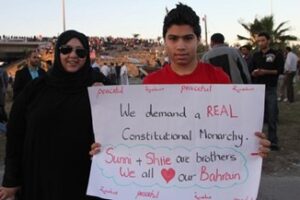 Spring, when the Sunni-ruled monarchies of Bahrain and Saudi Arabia branded the card of a Shi‘a and sectarian threat to discredit and fragment cross-sectarian popular protests (Matthiesen 2013) [Image at right]. Such (mis)conceptions, which are also popular amongst political circles and observers in the West, are often politically driven. They ignore the internal diversity of Shi‘a communities and Shi‘a Islamist groups, including different views and attitudes vis-à-vis the Islamic Republic of Iran and its model of governance (Louër 2012). Shi‘a politics are marred and driven by intra-Shi‘i cleavages and rivalries, whether the Shi‘a hold political power or not. Iraq’s 2018 protests, which are still ongoing, capture popular resentment at the failures of the Shi‘a-led government, the nature itself of a political system based on sectarian and ethnic quotas (muhassasa), as well as at Iran’s real or perceived influence.
Spring, when the Sunni-ruled monarchies of Bahrain and Saudi Arabia branded the card of a Shi‘a and sectarian threat to discredit and fragment cross-sectarian popular protests (Matthiesen 2013) [Image at right]. Such (mis)conceptions, which are also popular amongst political circles and observers in the West, are often politically driven. They ignore the internal diversity of Shi‘a communities and Shi‘a Islamist groups, including different views and attitudes vis-à-vis the Islamic Republic of Iran and its model of governance (Louër 2012). Shi‘a politics are marred and driven by intra-Shi‘i cleavages and rivalries, whether the Shi‘a hold political power or not. Iraq’s 2018 protests, which are still ongoing, capture popular resentment at the failures of the Shi‘a-led government, the nature itself of a political system based on sectarian and ethnic quotas (muhassasa), as well as at Iran’s real or perceived influence.
Image #1: Ali receiving the oath of allegiance.
Image #2: Ahmad bin Yahya, the penultimate Zaydi Imam and king of the Mutawakkilite Kingdom of Yemen (1948–62).
Image #3: The myth of Hasan al-Sabbah’s artificial paradise in his castle of Alamut, as depicted in Marco Polo’s Book of the Marvels of the World.
Image #4: Shah Isma‘il declares Shi‘ism as religion of state.
Image #5: Façade of the Mosque of al-Aqmar.
Image #6: Banner with the pictures of Ayatollah Khomeini and Ayatollah Khamenei on the Iranian flag.
Image #7: Joint prayer between Sunni and Shi‘a Muslims in Lucknow.
Image #8: Didar of Aga Khan IV in Tajikistan in 2008.
Image #9: Arba‘in pilgrimage to the shrine of Husayn in Karbala’.
Image #10: Imam al-Khoei Islamic Center, New York.
Image #11: Cross-sectarian Arab Spring protest in Bahrain.
REFERENCES
Abisaab, Rula Jurdi. 2004. Converting Persia: Religion and Power in the Safavid Empire. New York: I.B. Tauris.
Aga Khan Development Network website. 2020. Accessed from www.akdn.org on 15 December 2021.
Clarke, Morgan. 2018. Islam and Law in Lebanon: Sharia Within and Without the State. Cambridge: Cambridge University Press.
Corboz, Elvire. 2015. Guardians of Shi‘ism: Sacred Authority and Transnational Family Networks. Edinburgh: Edinburgh University Press.
Daftary, Farhad. 1998. A Short History of the Ismailis: Traditions of a Muslim Community. Edinburgh: Edinburgh University Press.
Deeb, Lara. 2006. An Enchanted Modern: Gender and Public Piety in Shi‘i Lebanon. Princeton: Princeton University Press.
Fibiger, Thomas. 2015. “Marja‘iyya from Below: Anthropological Approaches to the Study of Religious Authority.” Journal of Shi‘a Islamic Studies 8:473–89.
Haider, Najam. 2014. Shi‘i Islam: An Introduction. Cambridge: Cambridge University Press.
Haider, Najam. 2010. “Zaydism: A Theological and Political Survey”. Religion Compass 4(7): 436–442.
Haykel, Bernard, and Jonathan AC Brown. n.d. “Zaydi Madhhab.” In The [Oxford] Encyclopedia of Islam and Law. Oxford Islamic Studies Online. Accessed from http://www.oxfordislamicstudies.com/article/opr/t349/e0146 on 15 December 2021.
Gleave, Robert. 2007. Scripturalist Islam: The History and Doctrines of the Akhbari Shi‘i School. Leiden: Brill.
Khomeini, Ruhollah. 2002. Islam and Revolution. Translated and edited by Hamid Algar. London: Kegan Paul.
Louër, Laurence. 2012. Shiism and Politics in the Middle East. Translated by John King. London: Hurst.
Madelung, Wilferd. 2002. “Zaydiyya.” In Encyclopaedia of Islam. Second Edition. Leiden, The Netherlands: Brill.
Matthiesen, Toby. 2013. Sectarian Gulf: Bahrain, Saudi Arabia, and the Arab Spring That Wasn’t. Stanford: Stanford University Press.
Messick, Brinkley Morris. 1993. The Calligraphic State: Textual Domination and History in a Muslim Society. Berkeley: University of California Press.
Momen, Moojan. 2016. Shi‘i Islam: A Beginner’s Guide. London: Oneworld.
Newman, Andrew. 2009. Safavid Iran: Rebirth of a Persian Empire. London: I.B. Tauris.
Newman, Andrew J. 2013. Twelver Shiism: Unity and Diversity in the Life of Islam, 632 to 1722. Edinburgh: Edinburgh University Press.
Norton, Augustus Richard. 2014. Hezbollah: A Short History. Princeton: Princeton University Press.
Pew Forum on Religion & Public Life. 2009. Mapping the Global Muslim Population: A Report on the Size and Distribution of the World’s Muslim Population. Washington, DC: Pew Research Center. Accessed from https://www.pewresearch.org/wp-content/uploads/sites/7/2009/10/Muslimpopulation.pdf on 15 December 2021.
Walbridge, Linda S. 1996. Without Forgetting the Imam: Lebanese Shi‘ism in an American Community. Detroit: Wayne State University Press.
Who is Hussain. n.d. Accessed from https://whoishussain.org on 15 December 2021.
Zargar LIS. 2021. “Marja‘iyya between Law and Laity: The Requirements of Jurists as Imagined by their Followers.” Journal of the Contemporary Study of Islam 2:51–70.
SUPPLEMENTARY RESOURCES
Daftary, Farhad, and Zulfikar Hirji. 2008. The Ismailis: An Illustrated History. London: Azimuth.
Encyclopaedia of Islam, The. Second and third editions. Leiden: Brill. https://referenceworks.brillonline.com/browse/encyclopaedia-of-islam-2 and https://referenceworks.brillonline.com/browse/encyclopaedia-of-islam-3.
Encyclopædia Iranica. 1996–. Online edition. New York. www.iranicaonline.org.
Haddad, Fanar. 2020. Understanding ‘Sectarianism’: Sunni-Shi‘a Relations in the Modern Arab World. New York: Oxford University Press.
Longinotto, Kim, and Ziba Mir-Hosseini (dir.). 1998. Divorce Iranian Style. Documentary film.
Mottahedeh, Roy. 2000. The Mantle of the Prophet: Religion and Politics in Iran. Oxford: Oneworld.
Shii News and Resources. https://www.shii-news.imes.ed.ac.uk/.
Publication Date:
16 December 2021
